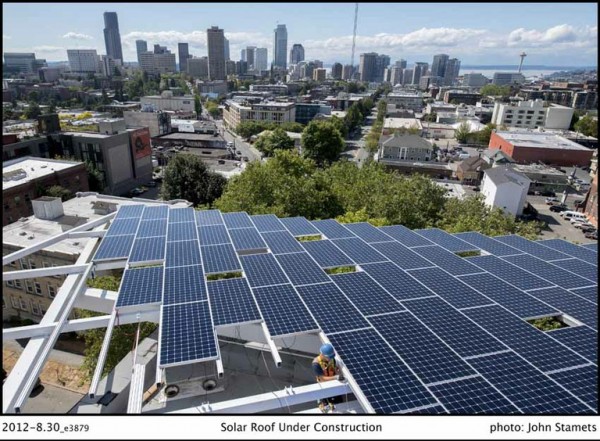On an uncharacteristically sunny and warm April day in Seattle, a ribbon-cutting ceremony was held for the new Bullitt Center, which is being called the “greenest commercial building” in the world. While this moniker is debatable, some hyperbole can be forgiven as it was April 22, Earth Day 2013, with one of Earth Day’s early organizers, Denis Hayes, in attendance.
Hayes, now the CEO of the Bullitt Foundation environmental organization, was joined at the ceremony by several Seattle dignitaries, including Mayor Mike McGinn and Washington State Gov. Jay Inslee. Guided tours of the new six-story structure were later given to the public throughout the afternoon.

The $18.5 million building, which is now 80 percent leased, is now the headquarters of the Bullitt Foundation, named for the founding family of Seattle television and radio station owners King Broadcasting. Other anchor tenants include the University of Washington’s Integrated Design Lab and the Cascadia Green Building Council.

Some of the cutting-edge sustainable features include a system to collect and filter “grey water” in underground cisterns for reuse throughout the building, a green roof to filter stormwater runoff, composting toilets, a 242-kW rooftop solar array to generate nearly all of the building’s electricity needs year-round, and large windows that will open to provide natural ventilation and sunlight. A solar-powered hydronic radiant heating system was also installed in the concrete floors, which will be supplemented with geothermal energy from 400-foot-deep heat-exchanger wells to heat and cool the offices.
Built-in sensors monitor light levels, CO2, indoor-outdoor temperatures and weather conditions. On the street outside, green planting strips and porous pavement materials will allow water to infiltrate into the soil below and reduce runoff into Puget Sound and nearby Lake Washington. To encourage mass transit use and walking within the building, the center has wide, inviting stairways and does not include a parking garage.

“Once somebody proves something is possible, it becomes thinkable,” said Hayes at the opening ceremony. The Bullitt Center, he added, will “help transform the way we build, here and around the world.”
The building uses so many groundbreaking environmental features, using 83 percent less energy than other comparably sized Seattle office buildings, that new city ordinances had to be written to accommodate them all, said Mayor McGinn. “It turns out sustainability isn’t legal now,” he quipped.
The Bullitt Center is expected to be so advanced that it is foregoing certification under the U.S. Green Building Council’s LEED program and aiming for the even more stringent Living Building Challenge (version 2.0), hosted by the International Living Building Institute. To be certified as a “Living Building,” a structure is required to be self-sufficient for energy and water for at least 12 continuous months and to meet rigorous standards for green materials and for the quality of its indoor environment.
“For those who say we can’t power our future, let them come to the Bullitt Center,” said Gov. Inslee at the ceremony. The Bullitt Center, he said, is “the beginning of the end of small-minded cynicism that says we can’t beat global warming.”